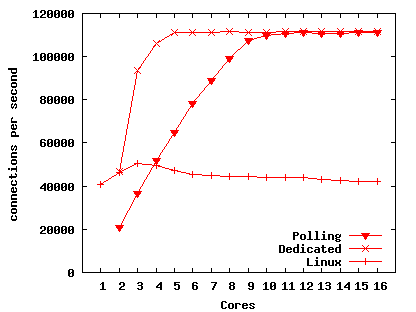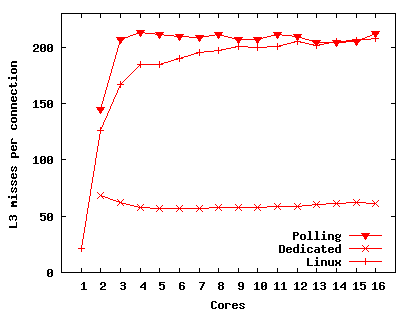
Corey: An Operating System for Many Cores
 MIT MIT
|
 Fudan University Fudan University
|
 Microsoft Research Asia Microsoft Research Asia
|
 Xi'an Jiaotong University Xi'an Jiaotong University
|
Abstract:
Multiprocessor application performance can be limited by the operating
system when the application uses the operating system frequently and
the operating system services use data structures shared and modified
by multiple processing cores. If the application does not need the
sharing, then the operating system will become an unnecessary
bottleneck to the application's performance.
This paper argues that applications should control sharing:
the kernel should arrange each data structure so that only a
single processor need update it, unless
directed otherwise by the application. Guided by this design
principle, this paper proposes three operating system abstractions
(address ranges, kernel cores, and shares) that allow applications to
control inter-core sharing and to take advantage of the likely abundance
of cores by dedicating cores to specific operating system functions.
Measurements of microbenchmarks on the Corey prototype operating system,
which embodies the new abstractions, show how control over sharing
can improve performance.
Application benchmarks, using MapReduce and a Web server, show
that the improvements can be significant for overall performance:
MapReduce
on Corey performs 25% faster than on Linux when using 16 cores.
Hardware event counters confirm that these improvements are due to
avoiding operations that are expensive on multicore machines.
1 Introduction
Cache-coherent shared-memory multiprocessor hardware
has become the default in modern PCs as chip
manufacturers have adopted multicore architectures. Chips with four
cores are common, and trends suggest that chips with tens to
hundreds of cores will appear within five years [2].
This paper explores new operating system abstractions that allow
applications to avoid bottlenecks in the operating system as the
number of cores increases.
Operating system services whose performance scales poorly with the
number of cores can dominate application performance.
Gough et al. show that contention for Linux's scheduling
queues can contribute significantly to total application run time on
two cores [12].
Veal and Foong show that as a Linux Web server uses more cores
directory lookups spend increasing amounts of time contending for
spin locks [29].
Section 8.5.1 shows that contention for Linux
address space
data structures causes the percentage of total time spent in the
reduce phase of a MapReduce application to increase from 5% at seven
cores to almost 30% at 16 cores.
One source of poorly scaling operating system services
is use of data structures modified by multiple cores.
Figure 1 illustrates such a scalability problem with a
simple microbenchmark. The benchmark creates a number of threads
within a process, each thread creates a file descriptor,
and then each thread repeatedly duplicates (with dup) its file descriptor and closes the result. The graph shows results on a
machine with four quad-core AMD Opteron chips running Linux 2.6.25.
Figure 1 shows that, as the number of cores increases,
the total number of dup and close operations per unit time
decreases. The cause is contention over
shared data: the table describing the process's
open files. With one core there are no cache misses, and the
benchmark is fast; with two cores,
the cache coherence protocol forces a few
cache misses per iteration to exchange the lock and table data. More
generally, only one thread at a time can update the shared file
descriptor table (which prevents any increase in performance),
and the increasing
number of threads spinning for the lock gradually increases locking
costs. This problem is not specific to Linux, but is due to POSIX
semantics, which require that a new file descriptor be visible to
all of a process's threads even if only one thread uses it.
Common approaches to increasing scalability include avoiding
shared data structures altogether, or designing them to
allow concurrent access via fine-grained locking
or wait-free primitives.
For example, the Linux community has made tremendous
progress with these approaches [18].
A different approach exploits the fact that some instances
of a given resource type need to be shared, while others do not.
If the operating system were aware of an application's
sharing requirements, it could choose resource implementations suited to
those requirements. A limiting factor in this approach is that the
operating system interface often does not convey the needed
information about sharing requirements. In the file descriptor example
above, it would be helpful if the thread could indicate
whether the new descriptor is private or usable by other
threads. In the former case it could be created in a per-thread
table without contention.
Figure 1:
Throughput of the file descriptor dup and close microbenchmark on Linux.
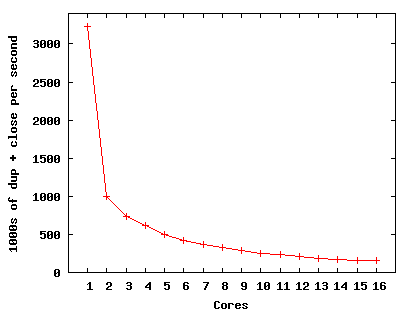
|
This paper is guided by a principle that generalizes the above observation:
applications should control sharing of operating system data
structures. ``Application'' is meant in a broad sense: the
entity that has enough information to make the sharing decision,
whether that be an operating
system service, an application-level library, or a traditional
user-level application.
This principle has two implications. First, the
operating system should arrange each of its data structures so that
by default only one core needs to use it,
to avoid forcing unwanted sharing. Second, the operating system
interfaces should let callers control how the operating system
shares data structures between cores.
The intended result is that the
operating system incurs sharing costs (e.g., cache
misses due to memory coherence) only when the
application designer has decided that is the best plan.
This paper introduces three new abstractions for applications
to control sharing within the operating system. Address ranges
allow applications to control which parts of the
address space are private per core and which are shared;
manipulating private regions
involves no contention or inter-core TLB invalidations, while
explicit indication of shared regions allows
sharing of hardware page tables and consequent minimization of
soft page faults (page faults that
occur when a core references pages with no mappings
in the hardware page table but which are present in physical memory).
Kernel cores allow applications to dedicate cores to run
specific kernel functions, avoiding contention over the
data those functions use. Shares are lookup
tables for kernel objects that allow applications to control
which object identifiers are visible to other cores. These abstractions are
implementable without inter-core sharing by default, but allow sharing
among cores as directed by applications.
We have implemented these abstractions in a prototype operating
system called Corey. Corey is organized
like an exokernel [9] to ease user-space prototyping
of experimental mechanisms. The Corey kernel provides the above
three abstractions. Most higher-level services are
implemented as library operating systems that use the abstractions to
control sharing. Corey runs on machines with AMD Opteron and
Intel Xeon processors.
Several benchmarks demonstrate the benefits of the new
abstractions. For example, a MapReduce application scales better with
address ranges on Corey than on Linux.
A
benchmark that creates and closes many short TCP connections shows that
Corey can saturate the network device with five cores by dedicating a
kernel core to manipulating the device driver state, while 11 cores
are required when not using a dedicated kernel core.
A synthetic Web
benchmark shows that Web applications can also benefit from dedicating
cores to data.
This paper should be viewed as making a case for controlling sharing
rather than demonstrating any absolute conclusions. Corey is an
incomplete prototype, and thus it may not be fair to compare it to
full-featured operating systems. In addition, changes in the
architecture of future multicore processors may change the
attractiveness of the ideas presented here.
The rest of the paper is organized as follows. Using
architecture-level microbenchmarks, Section 2 measures the
cost of sharing on multicore processors. Section 3
describes the three proposed abstractions to control sharing.
Section 4 presents the Corey kernel and
Section 5 its operating system
services. Section 6 summarizes the extensions to the
default system services that implement MapReduce and Web server
applications efficiently. Section 7 summarizes
the implementation of Corey.
Section 8 presents performance results.
Section 9 reflects on our results so far
and outlines directions for future work. Section 10 relates
Corey to previous work. Section 11 summarizes our
conclusions.
2 Multicore Challenges
The main goal of Corey is to allow applications to scale well with
the number of cores. This section details some hardware obstacles
to achieving that goal.
Future multicore chips are likely to have large total amounts of
on-chip cache, but split up among the many cores. Performance may be
greatly affected by how well software exploits the caches and the
interconnect between cores. For example, using data in a different
core's cache is likely to be faster than fetching data from
memory, and using data from a nearby core's cache may be faster than
using data from a core that is far away on the interconnect.
These properties can already be observed in current multicore
machines. Figure 2 summarizes the memory system of
a 16-core machine from AMD.
The machine has four quad-core Opteron
processors connected by a square interconnect.
The interconnect carries data between cores and memory,
as well as cache coherence broadcasts to locate and
invalidate cache lines, and point-to-point cache coherence
transfers of individual cache lines.
Each core has a private L1 and
L2 cache. Four cores on the same chip share an L3 cache. Cores on
one chip are connected by an internal crossbar switch and
can access each others' L1 and L2 caches
efficiently. Memory is
partitioned in four banks, each connected
to one of the four chips. Each core has a clock frequency
of 2.0 GHz.
Figure 2 also shows the
cost of loading a cache line from a local core, a nearby core, and a
distant core. We measured these numbers
using many of the techniques documented by Yotov et
al. [31]. The techniques avoid interference from
the operating system and hardware features such as cache line
prefetching.
Figure 2:
The AMD 16-core system topology. Memory access latency is in
cycles and listed before the backslash. Memory bandwidth is in
bytes per cycle and listed after the backslash.
The measurements
reflect the latency and bandwidth achieved by a core issuing load
instructions.
The
measurements for accessing the L1 or L2 caches of a different core
on the same chip
are the same. The measurements for accessing any cache on a different chip
are the same.
Each cache line is 64 bytes, L1 caches are 64 Kbytes 8-way set
associative, L2 caches are 512 Kbytes 16-way set associative, and L3
caches are 2 Mbytes 32-way set associative.

|
Reading from the local L3 cache on an AMD chip is faster than reading
from the cache of a different core on the same chip. Inter-chip reads
are slower, particularly when they go through two interconnect hops.
Figure 3 shows the performance scalability of locking,
an important primitive often dominated by cache miss costs.
The graph compares Linux's kernel spin
locks and scalable MCS locks [21] (on Corey) on the AMD machine,
varying the number of cores contending for the lock.
For both the kernel spin lock and the MCS
lock we measured the time required to acquire and release a
single lock. When only one core uses a lock,
both types of lock are fast because the lock is always
in the core's cache;
spin locks are faster than MCS locks because
the former requires three instructions to acquire
and release when not contended, while the latter requires 15.
The time for each successful acquire
increases for the spin lock with additional
cores because each new core adds a few more cache coherence
broadcasts per acquire, in order for the new core to observe
the effects of other cores' acquires and releases.
MCS locks avoid this cost by having each core spin on a separate
location.
We measured the average times required by Linux 2.6.25
to flush the TLBs of all cores after
a change to a shared page table.
These ``TLB shootdowns'' are considerably slower on 16
cores than on 2 (18742 cycles versus 5092 cycles).
TLB shootdown typically dominates the cost of removing a
mapping from an address space that is shared among multiple cores.
Figure 3:
Time required to acquire and release a lock on a
16-core AMD machine when varying number of cores contend for
the lock.
The two lines show
Linux kernel spin locks and MCS locks (on Corey).
A spin lock with one core takes about 11 nanoseconds;
an MCS lock about 26 nanoseconds.

|
On AMD 16-core systems, the speed difference between a
fast memory access and a slow memory access is a factor of 100, and
that factor is likely to grow with the number of cores.
Our measurements for the Intel Xeon show a similar speed difference.
For
performance, kernels must mainly access data in the local core's
cache. A contended or falsely shared cache line decreases
performance because many accesses are to remote caches.
Widely-shared and contended locks also decrease performance, even
if the critical sections they protect are only a few
instructions. These performance effects will be more damaging as the number of
cores increases, since the cost of accessing far-away caches
increases with the number of cores.
3 Design
Existing operating system abstractions are often difficult to
implement without sharing kernel data among cores, regardless
of whether the application needs the shared semantics.
The resulting unnecessary sharing and resulting contention can
limit application scalability.
This section gives three examples of unnecessary sharing and for each example introduces a
new abstraction that allows the application to decide if
and how to share. The intent is that these
abstractions will help applications to scale to large numbers of cores.
Figure 4:
Example address space configurations for MapReduce executing on
two cores. Lines
represent mappings. In this example a stack is one page and
results are three pages.

(a) A single address space.
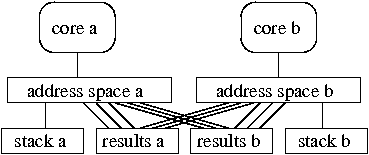
(b) Separate address spaces.
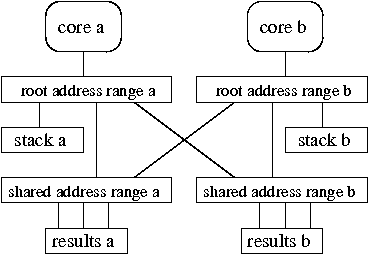
(c) Two address spaces with shared result mappings.
|
Parallel applications typically use memory in a mixture of two sharing
patterns: memory that is used on just one core (private), and
memory that multiple cores use (shared). Most operating systems
give the application a choice between two overall memory
configurations: a single address space shared by all cores or a separate
address space per core.
The term address space here refers to the description of how virtual
addresses map to memory, typically defined by kernel
data structures and instantiated lazily (in response to
soft page faults) in hardware-defined page tables or TLBs.
If an application chooses to harness concurrency using threads,
the result is typically a single address space shared by all threads.
If an application obtains concurrency by forking multiple
processes, the result is typically a private address space
per process; the processes can then map shared segments into all
address spaces.
The problem is that each of these two configurations
works well for only one of the sharing patterns, placing applications
with a mixture of patterns in a bind.
As an example, consider a MapReduce application [8].
During the map phase, each core reads part of the application's input
and produces intermediate results; map on each core writes its
intermediate results to a different area of memory. Each map instance
adds pages to its address space as it generates intermediate results.
During the reduce phase each core reads intermediate results produced
by multiple map instances to produce the output.
For MapReduce, a single address-space (see
Figure 4(a)) and separate per-core address-spaces
(see Figure 4(b)) incur
different costs. With a single address space, the map phase causes
contention as all cores add mappings to the kernel's
address space data structures. On the
other hand, a single address space is efficient for reduce because
once any core inserts a mapping into the underlying
hardware page table, all cores can use
the mapping without soft page faults. With separate address spaces,
the map phase sees no contention while adding mappings to the per-core
address spaces. However, the reduce phase will incur a soft page fault
per core per page of accessed intermediate results. Neither memory
configuration works well for the entire application.
We propose address ranges to give applications high performance for
both private and shared memory (see Figure 4(c)).
An address range is a kernel-provided abstraction that corresponds to a
range of virtual-to-physical mappings. An application can allocate
address ranges, insert mappings into them, and place an address range at
a desired spot in the address space. If multiple cores' address spaces
incorporate the same address range, then they will share the
corresponding pieces of hardware page tables, and see mappings inserted by each
others' soft page faults.
A core can update the mappings in a non-shared address range without
contention. Even when shared, the address range is the unit of locking; if
only one core manipulates the mappings in a shared address range, there will be
no contention. Finally, deletion of mappings from a non-shared address range
does not require TLB shootdowns.
Address ranges allow applications to selectively share parts of address
spaces, instead of being forced to make an all-or-nothing decision.
For example, the MapReduce runtime can set up address spaces as shown
in 4(c). Each core has a private root address range
that maps all private memory segments used for stacks and
temporary objects and several shared address ranges mapped by
all other cores.
A core can manipulate mappings in its private address ranges without
contention or TLB shootdowns.
If each core uses a different shared address range to store
the intermediate output of its map phase (as shown
Figure 4(c)), the map phases do not contend when
adding mappings.
During the reduce phase there are no
soft page faults when accessing shared segments, since all cores
share the corresponding parts of the hardware page tables.
In most operating systems, when application code on a core invokes a
system call, the same core executes the kernel code for the call.
If the system call uses shared kernel data structures,
it acquires locks and fetches relevant cache lines from the
last core to use the data. The
cache line fetches and lock acquisitions are costly if many cores use
the same shared kernel data. If the shared data is large, it may end
up replicated in many caches, potentially reducing total effective
cache space and increasing DRAM references.
We propose a kernel core abstraction that allows
applications to dedicate cores to kernel functions and data. A
kernel core can manage hardware devices and execute system calls
sent from other cores. For example, a Web service application may
dedicate a core to interacting with the network device instead of
having all cores manipulate and contend for driver and device data
structures (e.g., transmit and receive DMA descriptors).
Multiple application cores then communicate with the kernel
core via shared-memory IPC; the application cores exchange packet
buffers with the kernel core, and the kernel core manipulates the
network hardware to transmit and receive the packets.
This plan reduces the number of cores available to the Web
application, but it may improve overall performance by reducing
contention for driver data structures and associated locks.
Whether a
net performance improvement would result is something that the
operating system cannot easily predict. Corey provides the kernel core
abstraction so that applications can make the decision.
Many kernel operations involve looking up identifiers in tables to
yield a pointer to the relevant kernel data structure; file
descriptors and process IDs are examples of such identifiers. Use of
these tables can be costly when multiple cores contend for locks on
the tables and on the table entries themselves.
For each kind of lookup, the operating system interface designer or
implementer typically decides the scope of sharing of the
corresponding identifiers and tables. For example, Unix file
descriptors are shared among the threads of a process.
Process identifiers, on the other hand,
typically have global significance. Common implementations use
per-process and global lookup tables, respectively. If a particular
identifier used by an application needs only limited scope, but the
operating system implementation uses a more global lookup scheme, the
result may be needless contention over the lookup data structures.
We propose a share abstraction that allows applications to dynamically
create lookup tables and determine how these tables are shared. Each
of an application's
cores starts with one share (its root share), which is private to that
core. If two cores want to share a share, they create a share and add
the share's ID to their private root share (or to a share reachable
from their root share). A root share doesn't use a lock because it
is private, but a shared share does. An application can decide for each new
kernel object (including a new share) which share will hold the identifier.
Inside the kernel, a share maps application-visible identifiers to
kernel data pointers. The shares reachable from a core's
root share define which identifiers the core can use. Contention may
arise when two cores manipulate the same share, but applications can
avoid such contention by placing identifiers with limited sharing
scope in shares that are only reachable on a subset of the cores.
For example, shares could be used to implement file-descriptor-like
references to kernel objects. If only one thread uses a descriptor, it
can place the descriptor in its core's private root share. If the
descriptor is shared between two threads, these two threads can create
a share that holds the descriptor. If the descriptor is shared among
all threads of a process, the file descriptor can be put in a
per-process share. The advantage of shares is that the application
can limit sharing of lookup tables and avoid unnecessary contention if
a kernel object is not shared. The downside is that an application must
often keep track of the share in which it has placed each identifier.
4 Corey kernel
Corey provides a kernel interface
organized around five types of low-level objects: shares, segments,
address ranges, pcores, and devices. Library operating systems provide
higher-level system services that are implemented on top of these five types.
Applications
implement domain specific optimizations using the
low-level interface; for example, using pcores and devices they can
implement kernel cores. Figure 5 provides an overview
of the Corey low-level interface. The following sections describe
the design of the five types of Corey kernel objects and how they allow
applications to control sharing. Section 5 describes
Corey's higher-level system services.
Figure:
Corey system calls. shareid, segid, arid, pcoreid, and
devid represent 64-bit object IDs. share, seg, ar, pcore, obj, and
dev represent
< share ID, object ID >
pairs. hwid represents a unique ID for hardware devices and memid
represents a unique ID for per-core free page lists.
| System call |
Description |
| name obj_get_name(obj) |
return the name of an object |
shareid share_alloc(shareid, name, memid)
void share_addobj(shareid, obj)
void share_delobj(obj)
void self_drop(shareid)
|
allocate a share object
add a reference to a shared object to the specified share
remove an object from a share, decrementing its reference count
drop current core's reference to a share
|
segid segment_alloc(shareid, name, memid)
segid segment_copy(shareid, seg, name, mode)
nbytes segment_get_nbytes(seg)
void segment_set_nbytes(seg, nbytes)
|
allocate physical memory and return a segment object for it
copy a segment, optionally with copy-on-write or -read
get the size of a segment
set the size of a segment
|
arid ar_alloc(shareid, name, memid)
void ar_set_seg(ar, voff, segid, soff, len)
void ar_set_ar(ar, voff, ar1, aoff, len)
ar_mappings ar_get(ar)
|
allocate an address range object
map addresses at voff in ar to a segment's physical pages
map addresses at voff in ar to address range ar1
return the address mappings for a given address range
|
pcoreid pcore_alloc(shareid, name, memid)
pcore pcore_current(void)
void pcore_run(pcore, context)
void pcore_add_device(pcore, dev)
void pcore_set_interval(pcore, hz)
void pcore_halt(pcore)
|
allocate a physical core object
return a reference to the object for the current pcore
run the specified user context
specify device list to a kernel core
set the time slice period
halt the pcore
|
devid device_alloc(shareid, hwid, memid)
dev_list device_list(void)
dev_stat device_stat(dev)
void device_conf(dev, dev_conf)
void device_buf(dev, seg, offset, buf_type)
|
allocate the specified device and return a device object
return the list of devices
return information about the device
configure a device
feed a segment to the device object
|
locality_matrix locality_get(void)
|
get hardware locality information
|
The kernel maintains metadata describing each object. To reduce the
cost of allocating memory for object metadata, each core keeps a local
free page list. If the architecture is NUMA, a core's free page list
holds pages from its local memory node. The system call
interface allows the caller to
indicate which core's free list a new object's memory should be taken
from. Kernels on all cores can address all object metadata since each
kernel maps all of physical memory into its address space.
The Corey kernel generally locks an object's metadata before each use.
If the application has arranged things so that the object is only
used on one core, the lock and use of the metadata will be
fast (see Figure 3),
assuming they have not been evicted from the core's cache.
Corey uses spin lock and read-write lock implementations
borrowed from Linux, its own
MCS lock implementation, and a scalable read-write lock implementation
inspired by the MCS lock to synchronize access to object metadata.
An application allocates a Corey object by calling the
corresponding alloc system call, which returns a unique
64-bit object ID. In order for a kernel to use an object,
it must know the object ID (usually from a system call argument),
and it must map the ID to the address of the object's metadata.
Corey uses shares for this purpose.
Applications specify
which shares are available on which cores by passing
a core's share set to pcore_run (see below).
When allocating an object, an application selects a
share to hold the object ID. The application uses
< share ID, object ID >
pairs to specify objects
to system calls.
Applications can add a reference to an object in a share with
share_addobj and remove an
object from a share with share_delobj.
The kernel counts references to each object,
freeing the object's memory when the count is zero.
By convention, applications maintain a per-core
private share and one or more shared shares.
The kernel represents physical memory using the segment
abstraction. Applications use segment_alloc to
allocate segments and segment_copy to copy a segment or
mark the segment as copy-on-reference or copy-on-write. By default,
only the core that allocated the segment can reference it; an
application can arrange to share a segment between cores by adding it
to a share, as described above.
An application uses address ranges to define its
address space. Each running core has an associated root address range object
containing a table of address mappings. By convention, most applications
allocate a root address range for each core to hold core private mappings, such
as thread stacks, and use one or more address ranges that are shared by
all cores to hold shared segment mappings, such as dynamically allocated
buffers. An application uses ar_set_seg to cause
an address range to map addresses to the physical memory in a segment,
and ar_set_ar to set up a tree of address range mappings.
Corey represents physical cores with pcore
objects. Once allocated, an application can start
execution on a physical core by
invoking pcore_run and specifying a pcore object,
instruction and stack pointer, a set of shares, and an address range. A pcore
executes until pcore_halt is called. This
interface
allows Corey to space-multiplex applications
over cores, dedicating a set of cores to a
given application for a long period of time, and letting each
application manage its own cores.
An application configures a kernel core by allocating a
pcore object, specifying a list of devices with
pcore_add_device, and invoking pcore_run with the
kernel core option set in the context argument. A kernel core
continuously polls the
specified devices by invoking a device specific function. A
kernel core polls both real devices and special ``syscall''
pseudo-devices.
A syscall device allows an application to invoke
system calls on a kernel core. The application
communicates with the syscall device via a ring buffer in a
shared memory segment.
5 System services
This section describes three system services exported by Corey:
execution forking, network access, and a buffer cache.
These services together with a C standard library that includes support
for file descriptors, dynamic memory allocation, threading, and other
common Unix-like features create a scalable and convenient
application environment that is used by the applications
discussed in Section 6.
cfork is similar to Unix fork and is the main
abstraction
used by applications to extend execution to a new core.
cfork takes a physical core ID, allocates a
new pcore object and runs it. By default,
cfork shares little state between the parent and child pcore.
The caller marks most segments from its root address range as
copy-on-write and maps them into the root address range of the new
pcore.
Callers can instruct cfork to share specified segments
and address ranges with the
new processor. Applications
implement fine-grained sharing using shared segment mappings and more
coarse-grained sharing using shared address range
mappings. cfork callers can
share kernel objects with the new pcore by passing a set of shares for
the new pcore.
5.2 Network
Applications can choose to run several network stacks (possibly one
for each core) or a single shared network stack. Corey uses the
lwIP [19]
networking library.
Applications specify a network device for each lwIP stack. If
multiple network
stacks share a single physical device, Corey virtualizes the
network card. Network stacks on different cores that share a
physical network device also share the device driver data, such as the
transmit descriptor table and receive descriptor table.
All configurations we have experimented with run a separate network
stack for each core that requires network access. This design
provides good scalability but requires multiple IP addresses per
server and must balance requests using an external mechanism. A
potential solution is to extend the Corey virtual network driver to
use ARP negotiation to balance traffic between virtual network devices
and network stacks (similar to the Linux Ethernet bonding driver).
5.3 Buffer cache
An inter-core shared buffer cache is important to system performance
and often necessary for correctness when multiple cores access
shared files. Since cores share the buffer cache they might contend
on the data structures used to organize cached disk blocks.
Furthermore, under write-heavy workloads it is possible that cores
will contend for the cached disk blocks.
The Corey buffer cache resembles a traditional Unix buffer cache; however,
we found three
techniques that substantially improve multicore performance.
The first is a lock-free tree
that allows multiple cores to locate cached blocks
without contention. The second is a
write scheme that tries to minimize contention on shared data using
per-core block allocators and by copying application data into blocks
likely to be held in local hardware caches. The third
uses a scalable read-write lock to ensure blocks are not freed
or reused during reads.
6 Applications
It is unclear how big multicore systems will be used, but
parallel computation and network servers are
likely application areas. To evaluate Corey in
these areas, we implemented a MapReduce system
and a Web server with synthetic dynamic content.
Both applications are data-parallel but have
sharing requirements and thus are not trivially parallelized.
This section describes how the two applications use the
Corey interface to achieve high performance.
6.1 MapReduce applications
MapReduce is a framework for data-parallel execution
of simple programmer-supplied
functions. The
programmer need not be an expert in parallel programming to
achieve good parallel performance.
Data-parallel applications fit well
with the architecture of multicore machines, because each core has its
own private cache and can efficiently process data in that
cache. If the runtime does a good job of putting data in caches
close to the cores that manipulate that data, performance should
increase with the number of cores. The difficult part is
the global communication between the map and reduce phases.
We started with the Phoenix MapReduce implementation [22],
which is optimized for shared-memory multiprocessors.
We reimplemented Phoenix to simplify its implementation, to
use better algorithms for manipulating the intermediate data, and
to optimize its performance. We call this reimplementation Metis.
Metis on Corey exploits address ranges as described in
Section 3. Metis uses a separate address space on each
core, with private mappings for most data (e.g. local variables and
the input to map), so that each core can update its own page tables
without contention. Metis uses address ranges to share the
output of the map on each core with the reduce phase on other cores.
This arrangement avoids contention as each map instance adds
pages to hold its intermediate output, and
ensures that the reduce phase incurs no soft page faults while
processing intermediate data from the map phase.
6.2 Web server applications
Figure 6:
A Corey Web server configuration with two kernel cores, two
webd cores and three application cores. Rectangles
represent segments,
rounded rectangles represents pcores, and circles represent devices.
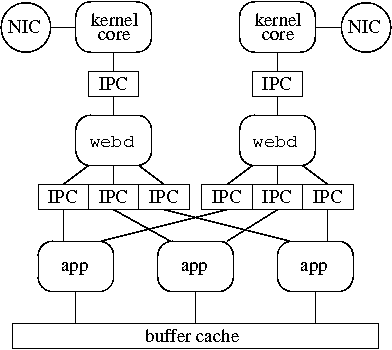 |
The main processing in a Web server includes low-level network device
handling, TCP processing, HTTP protocol parsing and formatting,
application processing (for dynamically generated content), and access
to application data. Much of this processing involves operating
system services. Different parts of the processing require different
parallelization strategies. For example, HTTP parsing is easy to
parallelize by connection, while application processing is often best
parallelized by partitioning application data across cores to avoid
multiple cores contending for the same data.
Even for read-only application data, such partitioning may help
maximize the amount of distinct data cached by avoiding duplicating
the same data in many cores' local caches.
The Corey Web server is built from three components: Web
daemons (webd),
kernel cores, and applications (see Figure 6).
The components communicate via shared-memory IPC.
Webd is responsible for
processing HTTP requests. Every core running a webd
front-end uses a private TCP/IP stack. Webd can manipulate
the network device directly or use a kernel
core to do so.
If using a kernel core, the TCP/IP stack of each core passes packets
to transmit and buffers to receive incoming packets to the kernel core
using a syscall device.
Webd parses HTTP requests and hands them off to a core
running application code.
The application core performs
the required computation and returns the results to
webd. Webd packages the
results in an HTTP response and transmits it, possibly using a kernel core.
Applications may run on dedicated cores (as shown in
Figure 6) or run on the same core as a webd
front-end.
All kernel objects
necessary for a webd core to complete a request, such as
packet buffer segments, network devices, and shared segments used for
IPC are referenced by a private per-webd core share.
Furthermore, most kernel objects, with the exception of the IPC
segments, are used by only one core.
With this design, once IPC segments have been mapped into
the webd and application address ranges, cores process requests
without contending over any global kernel data or locks,
except as needed by the application.
The application running with webd can run in two modes:
random mode and locality mode. In random mode,
webd forwards each request to a randomly chosen application core.
In locality mode, webd forwards each request to
a core chosen from a hash of the name of the data that will
be needed in the request.
Locality mode increases the probability that the application core will
have the needed data in its cache, and decreases
redundant caching of the same data.
7 Implementation
Corey runs on AMD Opteron and the Intel Xeon processors. Our
implementation is simplified
by using a 64-bit virtual address space, but nothing in the Corey
design relies on a large virtual address space. The implementation of
address ranges is geared towards architectures with hardware page tables.
Address ranges could be ported to TLB-only architectures, such as
MIPS, but would provide less performance benefit, because every
core must fill its own TLB.
The Corey implementation is divided into two parts: the low-level code that
implements Corey objects (described in Section 4) and the high-level Unix-like
environment (described in Section 5). The
low-level code (the kernel) executes in the supervisor protection domain.
The high-level Unix-like services are a library that applications link
with and execute in application protection domains.
The low-level kernel implementation, which includes
architecture specific functions and device drivers, is 11,000 lines of C
and 150 lines of assembly.
The Unix-like environment, 11,000 lines of C/C++, provides the buffer cache,
cfork, and TCP/IP stack interface as well as the Corey-specific glue
for the uClibc [28] C standard library, lwIP, and the
Streamflow [24] dynamic memory allocator. We fixed several bugs
in Streamflow and added support for x86-64 processors.
8 Evaluation
This section demonstrates the performance improvements
that can be obtained by allowing
applications to control sharing. We make
these points using several microbenchmarks evaluating address ranges,
kernel cores, and shares independently, as well as with the two
applications described in Section 6.
We ran all experiments on an AMD 16-core system (see
Figure 2 in Section 2) with
64 Gbytes of memory. We counted the number of cache misses and computed the
average latency of cache misses using the AMD hardware event counters.
All Linux experiments use Debian Linux with
kernel version 2.6.25 and pin one thread to each core. The kernel is
patched with perfctr 2.6.35 to
allow application access to hardware event counters.
For Linux MapReduce
experiments we used our version of Streamflow because it provided better
performance than other allocators we tried, such as
TCMalloc [11] and glibc 2.7 malloc.
All network
experiments were performed on a gigabit switched network,
using the server's Intel Pro/1000 Ethernet device.
We also have run many of the experiments with Corey and
Linux on a 16-core Intel machine and with Windows on 16-core AMD and
Intel machines, and we draw conclusions similar to the ones
reported in this section.
To evaluate the benefits of address ranges in Corey, we need to
investigate two costs in multicore applications where
some memory is private and some is shared. First, the contention
costs of manipulating mappings for private memory. Second, the soft
page-fault costs for memory that is used on multiple cores. We expect
Corey to have low costs for both situations. We expect other systems
(represented by Linux in these experiments) to have low cost for only
one type of sharing, but not both, depending on whether the
application uses a single address space shared by all cores or a
separate address space per core.
The memclone [3] benchmark explores the costs of
private memory. Memclone has each core allocate a 100 Mbyte
array and modify each page of its array.
The memory is demand-zero-fill: the kernel initially allocates no
memory, and allocates pages only in response to page faults.
The kernel allocates the memory from the DRAM system
connected to the core's chip.
The benchmark measures the average time to modify each page.
Memclone allocates cores from chips in a round-robin
fashion. For example, when using five cores, memclone
allocates two cores from one chip and one core from each of the other
three chips.
Figure 7(a) presents the results for three
situations: Linux with a single address space shared by per-core threads,
Linux with a separate address space (process) per core but with the
100 Mbyte arrays mmaped into each process, and Corey with separate
address spaces but with the arrays mapped via shared address ranges.
Figure 7:
Address ranges microbenchmark results.
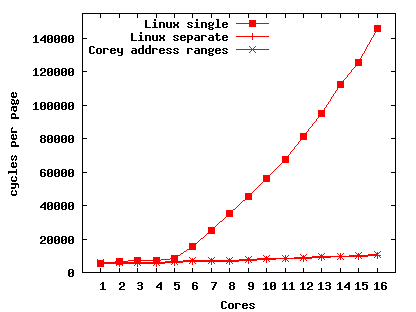
|
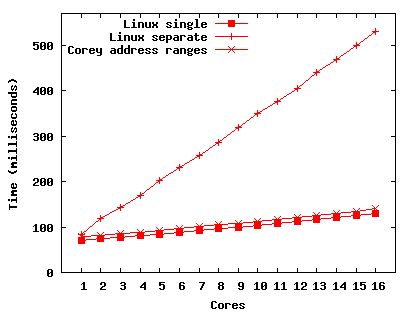
|
| (a)memclone |
(b)mempass |
Memclone scales well on Corey and on Linux with separate
address spaces, but poorly on Linux with a single address space.
On a page fault both Corey and Linux verify that the faulting address is
valid, allocate and clear a 4 Kbyte physical page, and insert the physical page
into the hardware page table. Clearing a 4 Kbyte page incurs 64 L3 cache
misses and copies 4 Kbytes from DRAM to the local L1 cache and writes
4 Kbytes from the L3 back to DRAM; however, the AMD cache line
prefetcher allows a core to clear a page in 3350 cycles (or at a rate
of 1.2 bytes per cycle).
Corey and Linux with separate address spaces each incur only 64 cache misses
per page fault, regardless of the number of cores. However, the cycles per page
gradually increases because the per-chip memory controller can only
clear 1.7 bytes per cycle and is saturated when memclone
uses more than two cores on a chip.
For Linux with a single address space cores contend over shared
address space data structures. With six cores the cache-coherency messages
generated from locking and manipulating the shared address space begin to congest
the interconnect, which increases the cycles required for processing a page
fault. Processing a page fault takes 14 times longer with 16 cores than with one.
We use a benchmark called mempass to evaluate the costs
of memory that is used on multiple cores. Mempass
allocates a single 100 Mbyte shared buffer on one of the cores, touches each
page of the buffer,
and then passes it to another core, which repeats the process until
every core touches every page. Mempass measures the total time for
every core to touch every page.
Figure 7(b) presents the results for the same
configurations used in memclone. This time Linux with
a single address space performs well, while Linux with separate
address spaces performs poorly. Corey performs well here too. Separate
address spaces are costly with this workload because each core
separately takes a soft page fault for the shared page.
To summarize, a Corey application can use address ranges to get good
performance for both shared and private memory. In contrast, a Linux
application can get good performance for only one of these types of
memory.
This section explores an example in which use of the Corey kernel core
abstraction improves scalability. The benchmark application is a
simple TCP service, which accepts incoming connections, writing 128
bytes to each connection before closing it. Up to 15 separate client
machines (as many as there are active server cores) generate the
connection requests.
We compare two server configurations. One of them (called
``Dedicated'') uses a kernel core to handle all network device
processing: placing packet buffer pointers in device DMA descriptors,
polling for received packets and transmit completions, triggering
device transmissions, and manipulating corresponding driver data
structures. The second configuration, called ``Polling'', uses a
kernel core only to poll for received packet notifications
and transmit completions. In both
cases, each other core runs a private TCP/IP stack and an instance of
the TCP service. For Dedicated, each service core uses shared-memory
IPC to send and receive packet buffers with the kernel core. For
Polling, each service core transmits packets and registers receive
packet buffers by directly manipulating the device
DMA descriptors (with locking), and is notified of received packets
via IPC from the Polling
kernel core. The purpose of the comparison is to show the effect on
performance of moving all device processing to the Dedicated kernel
core, thereby eliminating contention over device driver data
structures. Both configurations poll for received packets, since
otherwise interrupt costs would dominate performance.
Figure 8:
TCP microbenchmark results.
|
| (a) Throughput. |
(b) L3 cache misses. |
Figure 8(a) presents the results of the TCP benchmark.
The network device appears to be capable of handling only about 900,000
packets per second in total, which limits the throughput to about
110,000 connections per second in all configurations (each connection
involves 4 input and 4 output packets). The dedicated configuration
reaches 110,000 with only five cores, while Polling requires 11 cores.
That is, each core is able to handle more connections per second in
the Dedicated configuration than in Polling.
Most of this difference in performance is due to the Dedicated
configuration incurring fewer L3 misses. Figure 8(b)
shows the number of L3 misses per connection. Dedicated incurs about
50 L3 misses per connection, or slightly more than six per packet. These
include misses to manipulate the IPC data structures (shared with the
core that sent or received the packet) and the device DMA descriptors
(shared with the device) and the misses for a core to read a received
packet.
Polling incurs about 25 L3 misses per packet; the difference
is due to misses on driver data structures (such as indexes into the
DMA descriptor rings) and the locks that protect them. To
process a packet the device driver must acquire and release an MCS
lock twice: once to place the packet on DMA ring buffer and once
to remove it.
Since each L3 miss takes about 100 nanoseconds to
service, misses account for slightly less than half the total cost for
the Polling configuration to process a connection (with two cores).
This analysis is consistent with Dedicated
processing about twice as many connections with two cores,
since Dedicated has many fewer misses.
This
approximate relationship holds up to the 110,000 connection per second
limit.
The Linux results are presented for reference.
In Linux every core shares the same network stack and a core polls the
network device when the packet rate is high.
All cores place output packets on a
software
transmit queue. Packets may be removed from the software queue by any
core, but usually the polling core transfers the packets from the
software queue to the hardware transmit buffer on the network device.
On packet reception, the polling core removes the
packet from the ring buffer and performs the processing necessary to
place the packet on the queue of a TCP socket where it can be read by
the application.
With two cores, most cycles on
both cores are used by the kernel; however, as the number of cores
increases the polling core quickly becomes a bottleneck and other
cores have many idle cycles.
The TCP microbenchmark results demonstrate that a Corey application
can use kernel cores to improve
scalability by dedicating cores to handling kernel functions and
data.
We demonstrate the benefits of shares on Corey by comparing the results of two
microbenchmarks. In the first microbenchmark each core calls
share_addobj to add a per-core segment to a global share and then
removes the segment from the share with share_delobj. The benchmark
measures the throughput of add and remove operations.
As the number of cores increases, cores contend on
the scalable read-write lock protecting the hashtable used to implement the
share. The second microbenchmark is similar
to the first, except each core adds a per-core segment to a local share so that
the cores do not contend.
Figure 9:
Share microbenchmark results.
 |
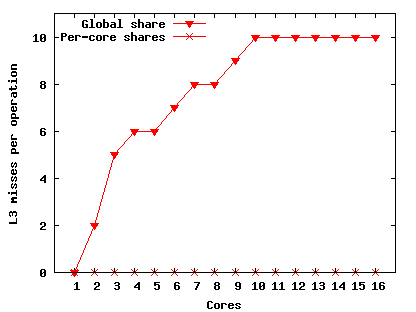 |
| (a) Throughput. |
(b) L3 cache misses. |
Figure 9 presents the results.
The global share scales relatively well for the first three cores, but at four
cores performance begins to slowly decline.
Cores contend on the global share, which increases the amount of cache
coherence traffic and makes manipulating the global share more
expensive. The local shares scale perfectly.
At 16 cores adding to and
removing from the global share costs 10 L3 cache misses, while no L3 cache
misses result from
the pair of operations in a local
share.
We measured the L3 misses for the Linux file descriptor microbenchmark described
in Section 1. On one core a duplicate and close incurs no L3
cache misses; however, L3 misses increase with the number of cores
and at 16 cores a dup and close costs 51 L3 cache
misses.
A Corey application can use shares to avoid bottlenecks that
might be caused by contention on kernel data structures when
creating and manipulating kernel objects. A Linux application, on
the other hand,
must use sharing policies specified by kernel implementers, which might
force inter-core sharing and unnecessarily limit scalability.
To demonstrate that address ranges, kernel cores, and shares have an impact on
application performance we presents benchmark results from the Corey port of
Metis and from webd.
8.5.1 MapReduce
We compare Metis on Corey and on Linux, using the wri
MapReduce application to build a reverse index of the words in a
1 Gbyte file. Metis allocates 2 Gbytes to hold intermediate values
and like memclone, Metis allocates cores from chips in a
round-robin fashion.
Figure 10:
MapReduce wri results.
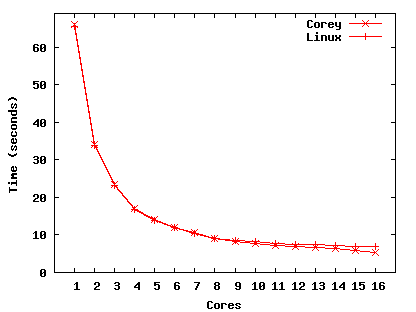 |
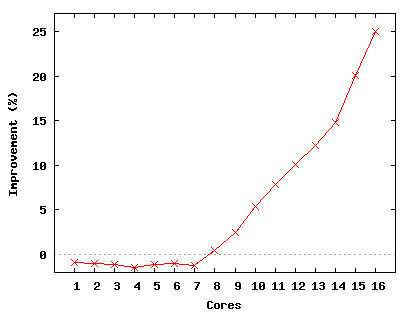 |
| (a) Corey and Linux performance. |
(b) Corey improvement over Linux. |
On Linux, cores share a single address space. On Corey each core
maps the memory segments holding intermediate results
using per-core shared address ranges. During the map phase each core
writes < word, index >
key-value pairs to
its per-core intermediate results memory.
For pairs with the same word, the indices are grouped
as an array.
More than 80% of the map phase is spent
in strcmp, leaving little scope for
improvement from address ranges.
During the reduce phase each core copies all the indices
for each word it is responsible for
from the intermediate result memories of all cores to a freshly
allocated buffer. The reduce phase
spends most of its time copying memory and
handling soft page faults. As the number of cores
increases, Linux cores contend while manipulating address space data
while Corey's address ranges keep contention costs low.
Figure 10(a) presents the absolute performance of
wri on Corey and Linux and Figure 10(b)
shows Corey's improvement relative to Linux.
For less than eight cores Linux is 1% faster than Corey because
Linux's soft page fault handler is about 10% faster than Corey's when there
is no contention.
With eight cores on Linux, address space contention costs
during reduce cause execution time for reduce to increase
from 0.47 to 0.58 seconds, while Corey's reduce time
decreases from 0.46 to 0.42
seconds. The time to complete the reduce phase continues to increase
on Linux and decrease on Corey as more cores are used.
At 16 cores the reduce phase takes
1.9 seconds on Linux and only 0.35 seconds on Corey.
As described in Section 6.2, applications might be able to
increase performance by dedicating application data to cores. We
explore this possibility using a webd application
called filesum. Filesum expects a file name as
argument, and returns the sum of the bytes in that file.
Filesum can be configured in two modes. ``Random'' mode
sums the file on a random core and ``Locality'' mode assigns each file
to a particular core and sums a requested file on its assigned
core. Figure 11 presents a four core configuration.
Figure 11:
A webd configuration with two front-end cores and two
filesum cores. Rectangles represent segments, rounded
rectangles represents pcores, and the circle represents a network device.
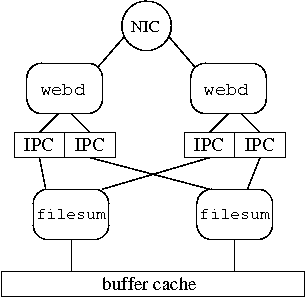 |
We measured the throughput of webd with filesum in
Random mode and in Locality mode. We configured webd front-end
servers on eight cores and filesum on eight cores. This experiment
did not use a kernel core or device polling. A single core handles
network interrupts, and all cores running
webd directly manipulate the network device.
Clients
only request files from a set of eight, so each filesum
core is assigned one file, which it maps into memory.
The HTTP
front-end cores and filesum cores exchange file requests and
responses using a shared memory segment.
Figure 12 presents the results of Random mode and
Locality mode. For file sizes of 256 Kbytes and smaller
the performance of Locality and Random mode are both limited by
the performance of the webd front-ends' network stacks. In
Locality mode, each
filesum core can store its assigned 512 Kbyte or 1024 Kbyte
file in chip caches. For 512 Kbyte files Locality mode achieves 3.1
times greater throughput than Random and for 1024 Kbyte files locality
mode achieves 7.5 times greater throughput. Larger files cannot be fit
in chip caches and the performance of both Locality mode and Random
mode is limited by DRAM performance.
Figure 12:
Throughput of Random mode and Locality mode.
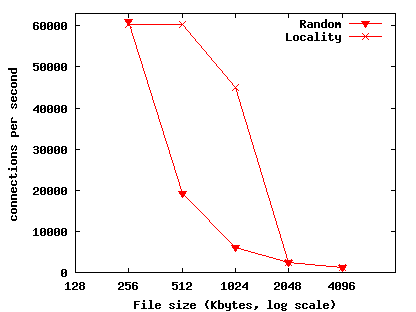 |
9 Discussion and future work
The results above should be viewed as a case for the principle that
applications should control sharing rather than a conclusive
``proof''. Corey lacks many features of
commodity operating systems, such as Linux, which influences
experimental results both positively and negatively.
Many of the ideas in Corey could be applied to
existing operating systems such as Linux.
The Linux kernel could use a variant of address ranges internally,
and perhaps allow application control via mmap flags.
Applications could use kernel-core-like mechanisms to reduce
system call invocation costs, to avoid concurrent access to
kernel data, or to manage an application's sharing of its
own data using techniques like
computation migration [6,14].
Finally, it may be possible for Linux to provide
share-like control over the sharing of file descriptors,
entries in buffer and directory lookup caches, and
network stacks.
10 Related work
Corey is influenced by Disco [5] (and its
relatives [30,13]), which runs
as a virtual machine monitor on a NUMA machine.
Like Disco, Corey aims to avoid kernel bottlenecks with
a small kernel that minimizes shared data.
However, Corey has a kernel interface like an
exokernel [9] rather than a virtual machine
monitor.
Corey's focus on supporting library operating systems
resembles
Disco's SPLASHOS, a runtime tailored for running the
Splash benchmark [26]. Corey's library operating systems
require more operating system features, which has led to
the Corey kernel providing a number of novel ideas to allow libraries to
control sharing (address ranges, kernel cores, and shares).
K42 [3] and Tornado [10], like Corey, are
designed so that independent applications do not contend over
resources managed by the kernel. The K42 and Tornado kernels provide
clustered objects that allow
different implementations based on sharing patterns.
The Corey kernel takes a
different approach;
applications customize sharing policies as needed instead of
selecting from a set of policies provided by kernel implementers.
In addition, Corey provides new abstractions not
present in K42 and Tornado.
Much work has been done on making widely-used operating systems run
well on multiprocessors [4]. The Linux
community has made many changes to improve scalability
(e.g., Read-Copy-Update (RCU) [20] locks,
local runqueues [1],
libnuma [16], improved load-balancing
support [17]). These
techniques are complementary to the new
techniques that Corey introduces and have been a source of
inspiration. For example, Corey uses tricks inspired by RCU to
implement efficient functions for retrieving and removing objects from
a share.
As mentioned in the Introduction, Gough et
al. [12] and Veal and Foong [29]
have identified Linux scaling challenges in the kernel implementations
of scheduling and directory lookup, respectively.
Saha et al. have proposed the Multi-Core Run Time (McRT) for
desktop workloads [23] and have explored dedicating
some cores to McRT and the application and others to the operating system.
Corey also uses spatial multiplexing, but provides a
new kernel that runs on all cores and that allows applications to
dedicate kernel functions to cores through kernel cores.
An Intel white paper reports use of spatial multiplexing of
packet processing in a network analyzer [15],
with performance considerations similar to
webd running in Locality or Random modes.
Effective use of multicore processors has many aspects and potential
solution approaches; Corey explores only a few. For example,
applications could be assisted in coping with heterogeneous
hardware [25]; threads could be automatically assigned to
cores in a way that minimizes cache
misses [27]; or applications could schedule
work in order to minimize the number of times a given datum needs to
be loaded from DRAM [7].
11 Conclusions
This paper argues that,
in order for applications to scale on multicore architectures,
applications must control sharing.
Corey is a new kernel that follows this principle. Its
address range, kernel core, and share abstractions ensure that
each kernel data structure is used by only one core by default, while
giving applications the ability to specify when sharing of
kernel data is necessary.
Experiments with a MapReduce application and a
synthetic Web application demonstrate that Corey's design allows
these applications to avoid scalability bottlenecks in the operating
system and outperform Linux on 16-core machines. We hope that the
Corey ideas will help applications to scale to the larger number of
cores on future processors. All Corey source code is publicly
available.
We thank
Russ Cox,
Austin Clements,
Evan Jones,
Emil Sit,
Xi Wang,
and our shepherd, Wolfgang Schröder-Preikschat,
for their feedback.
The NSF partially funded this work through award number 0834415.
- 1
-
J. Aas.
Understanding the Linux 2.6.8.1 CPU scheduler, February 2005.
https://josh.trancesoftware.com/linux/.
- 2
-
A. Agarwal and M. Levy.
Thousand-core chips: the kill rule for multicore.
In Proceedings of the 44th Annual Conference on Design
Automation, pages 750-753, 2007.
- 3
-
J. Appavoo, D. D. Silva, O. Krieger, M. Auslander, M. Ostrowski, B. Rosenburg,
A. Waterland, R. W. Wisniewski, J. Xenidis, M. Stumm, and L. Soares.
Experience distributing objects in an SMMP OS.
ACM Trans. Comput. Syst., 25(3):6, 2007.
- 4
-
R. Bryant, J. Hawkes, J. Steiner, J. Barnes, and J. Higdon.
Scaling linux to the extreme.
In Proceedings of the Linux Symposium 2004, pages 133-148,
Ottawa, Ontario, June 2004.
- 5
-
E. Bugnion, S. Devine, and M. Rosenblum.
DISCO: running commodity operating systems on scalable
multiprocessors.
In Proceedings of the 16th ACM Symposium on Operating Systems
Principles, pages 143-156, Saint-Malo, France, October 1997. ACM.
- 6
-
M. C. Carlisle and A. Rogers.
Software caching and computation migration in Olden.
In Proceedings of the 5th ACM SIGPLAN Symposium on Principles
and Practice of Parallel Programming, 1995.
- 7
-
S. Chen, P. B. Gibbons, M. Kozuch, V. Liaskovitis, A. Ailamaki, G. E. Blelloch,
B. Falsafi, L. Fix, N. Hardavellas, T. C. Mowry, and C. Wilkerson.
Scheduling Threads for Constructive Cache Sharing on CMPs.
In Proceedings of the 19th ACM Symposium on Parallel Algorithms
and Architectures, pages 105-115. ACM, 2007.
- 8
-
J. Dean and S. Ghemawat.
MapReduce: simplified data processing on large clusters.
Commun. ACM, 51(1):107-113, 2008.
- 9
-
D. R. Engler, M. F. Kaashoek, and J. W. O'Toole.
Exokernel: An operating system architecture for application-level
resource management.
In Proceedings of the 15th ACM Symposium on Operating Systems
Principles, pages 251-266, Copper Mountain, CO, December 1995. ACM.
- 10
-
B. Gamsa, O. Krieger, J. Appavoo, and M. Stumm.
Tornado: maximizing locality and concurrency in a shared memory
multiprocessor operating system.
In Proceedings of the 3rd Symposium on Operating Systems Design
and Implementation, pages 87-100, 1999.
- 11
-
Google Performance Tools.
https://goog-perftools.sourceforge.net/.
- 12
-
C. Gough, S. Siddha, and K. Chen.
Kernel scalability--expanding the horizon beyond fine grain locks.
In Proceedings of the Linux Symposium 2007, pages 153-165,
Ottawa, Ontario, June 2007.
- 13
-
K. Govil, D. Teodosiu, Y. Huang, and M. Rosenblum.
Cellular Disco: resource management using virtual clusters on
shared-memory multiprocessors.
In Proceedings of the 17th ACM Symposium on Operating Systems
Principles, pages 154-169, Kiawah Island, SC, October 1999. ACM.
- 14
-
W. C. Hsieh, M. F. Kaashoek, and W. E. Weihl.
Dynamic computation migration in dsm systems.
In Supercomputing '96: Proceedings of the 1996 ACM/IEEE
conference on Supercomputing (CDROM), Washington, DC, USA, 1996.
- 15
-
Intel.
Supra-linear Packet Processing Performance with Intel Multi-core
Processors.
ftp://download.intel.com/technology/advanced_comm/31156601.pdf.
- 16
-
A. Klein.
An NUMA API for Linux, August 2004.
https://www.firstfloor.org/ andi/numa.html.
- 17
-
Linux kernel mailing list.
https://kerneltrap.org/node/8059.
- 18
-
Linux Symposium.
https://www.linuxsymposium.org/.
- 19
-
lwIP.
https://savannah.nongnu.org/projects/lwip/.
- 20
-
P. E. McKenney, D. Sarma, A. Arcangeli, A. Kleen, O. Krieger, and R. Russell.
Read-copy update.
In Proceedings of the Linux Symposium 2002, pages 338-367,
Ottawa, Ontario, June 2002.
- 21
-
J. M. Mellor-Crummey and M. L. Scott.
Algorithms for scalable synchronization on shared-memory
multiprocessors.
ACM Trans. Comput. Syst., 9(1):21-65, 1991.
- 22
-
C. Ranger, R. Raghuraman, A. Penmetsa, G. Bradski, and C. Kozyrakis.
Evaluating MapReduce for Multi-core and Multiprocessor Systems.
In Proceedings of the 13th International Symposium on High
Performance Computer Architecture, pages 13-24. IEEE Computer Society,
2007.
- 23
-
B. Saha, A.-R. Adl-Tabatabai, A. Ghuloum, M. Rajagopalan, R. L. Hudson,
L. Petersen, V. Menon, B. Murphy, T. Shpeisman, E. Sprangle, A. Rohillah,
D. Carmean, and J. Fang.
Enabling scalability and performance in a large-scale CMP
environment.
In Proceedings of the 2nd ACM SIGOPS/EuroSys European Conference
on Computer Systems, pages 73-86, New York, NY, USA, 2007. ACM.
- 24
-
S. Schneider, C. D. Antonopoulos, and D. S. Nikolopoulos.
Scalable Locality-Conscious Multithreaded Memory Allocation.
In Proceedings of the 2006 ACM SIGPLAN International Symposium
on Memory Management, pages 84-94, 2006.
- 25
-
A. Schüpbach, S. Peter, A. Baumann, T. Roscoe, P. Barham, T. Harris, and
R. Isaacs.
Embracing diversity in the Barrelfish manycore operating system.
In Proceedings of the Workshop on Managed Many-Core Systems
(MMCS), Boston, MA, USA, June 2008.
- 26
-
J. P. Singh, W.-D. Weber, and A. Gupta.
SPLASH: Stanford Parallel Applications for Shared-Memory.
Computer Architecture News, 20(1):5-44.
- 27
-
D. Tam, R. Azimi, and M. Stumm.
Thread clustering: sharing-aware scheduling on SMP-CMP-SMT
multiprocessors.
In Proceedings of the 2nd ACM SIGOPS/EuroSys European Conference
on Computer Systems, pages 47-58, New York, NY, USA, 2007. ACM.
- 28
-
uClibc.
https://www.uclibc.org/.
- 29
-
B. Veal and A. Foong.
Performance scalability of a multi-core web server.
In Proceedings of the 3rd ACM/IEEE Symposium on Architecture for
networking and communications systems, pages 57-66, New York, NY, USA,
2007. ACM.
- 30
-
B. Verghese, S. Devine, A. Gupta, and M. Rosenblum.
Operating system support for improving data locality on CC-NUMA
compute servers.
In Proceedings of the 7th international conference on
Architectural support for programming languages and operating systems, pages
279-289, New York, NY, USA, 1996. ACM.
- 31
-
K. Yotov, K. Pingali, and P. Stodghill.
Automatic measurement of memory hierarchy parameters.
SIGMETRICS Perform. Eval. Rev., 33(1):181-192, 2005.
Corey: An Operating System for Many Cores
This document was generated using the
LaTeX2HTML translator Version 2002-2-1 (1.71)
Copyright © 1993, 1994, 1995, 1996,
Nikos Drakos,
Computer Based Learning Unit, University of Leeds.
Copyright © 1997, 1998, 1999,
Ross Moore,
Mathematics Department, Macquarie University, Sydney.
The command line arguments were:
latex2html -split 0 -no_navigation -no_footnode -show_section_numbers -local_icons -dir noshare-html noshare.ltx
The translation was initiated by Silas Boyd-Wickizer on 2008-10-14
Silas Boyd-Wickizer
2008-10-14
![]() Haibo Chen
Haibo Chen![]() Rong Chen
Rong Chen![]() Yandong Mao
Yandong Mao![]()
![]() Robert Morris
Robert Morris![]() Aleksey Pesterev
Aleksey Pesterev![]() Lex Stein
Lex Stein![]() Ming Wu
Ming Wu![]()
![]() Yang Zhang
Yang Zhang![]() Zheng Zhang
Zheng Zhang![]()










